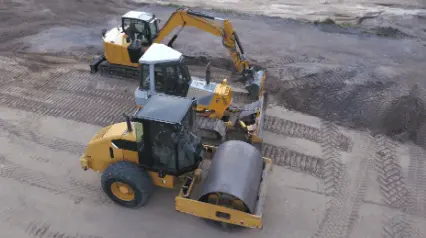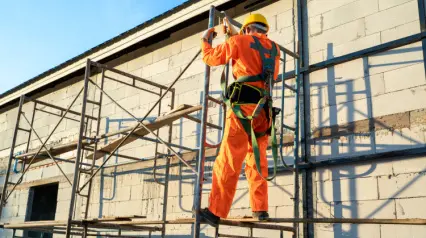What is Grading in Construction?
Grading in construction, typically called site grading, refers to the act of ensuring a level base or getting a specific slope on the land. This is an essential part of site preparation, which needs to be done before construction begins.
When grading the land, the construction team sculpts the surface to get the desired result. Generally, grading is necessary to ensure a level base for the structure. However, it’s also used to produce specific slopes on an area.
The primary objectives of site grading include:
- Ensure a proper drainage system
- Get the property’s desired aesthetics
- Reduce environmental impact by ensuring water runoff and reducing erosion and pollutants
- Comply with any relevant local rules, restrictions, and regulations
Importance of Site Grading
If the land isn’t graded properly, the building may have structural issues, differ from the original architectural concept, affect drainage, and even cause a negative environmental impact. For most construction projects, land grading is essential to ensure construction safety and that the project yields the desired results.
To start, site grading is crucial for drainage. When building on an uneven surface, water won’t drain out properly. So, it’s very important to prepare the land and ensure that it’s leveled before construction begins and direct water away from the site.
Additionally, land grading allows for a more solid foundation. When the land is properly graded, the structure’s base will be more steady, ensuring more structural integrity.
On top of all of that, site grading also improves the aesthetics of the site. A smooth land area is more visually pleasing and crucial for the finished structure. Besides that, an uneven area may also cause logistical issues during the project.
Types of Site Grading
There are various types of site grading required for different construction projects. These include:
Landscape Grading
Basically, landscape grading refers to the act of altering the land area to create better irrigation and to reshape the land entirely. This usually requires the removal of the topsoil, modifying slopes, implementing a drainage system, smoothening the soil for plants, or changing the entire appearance of the land.
Regrading
Regrading refers to the act of lowering or raising certain areas of the land. This can be done in both large and small areas and is usually required for irrigation.
Architectural Grading
This type of grading is performed on properties before building a new home, building, or commercial property. This process involves changing the entire contours of the landscape to allow for better drainage and a level base, and shaping the land to fit the project.
Rough Grading
Rough grading is done to set the slope or level of an area before the construction project. This provides a base for developing turf and resolves any drainage issues. This is done at the start to get the basic desired shape of the land.
Finish Grading
Finish grading is only done for specific projects like gravel roads and earthworks. This type of grading includes the surface and cover of the finished projects. In landscaping projects, finish grading refers to getting the ideal shape for the land. This is done right before planting, seeding, and sodding.
Final Grade
In landscape projects, a final grade is usually necessary. This process involves placing a top layer on top of the graded land to promote plant growth. During the final grade, teams usually apply a layer of topsoil, allowing for better plant growth.
How to Develop a Grading Strategy
When grading the land before starting construction, it’s best to develop a proper grading strategy beforehand. This allows the team to have an outline of the grading process and know exactly what to do each step of the way.
Typically, a grading plan is a complex set of documents that may seem baffling to the untrained eye. This is because the civil engineer is usually in charge of developing the grading plan, which is supposed to contain a plethora of information for other engineers, zoning and construction authorities, and evening building commissioners.
When developing a grading strategy, it’s important to have a 3-dimensional illustration of the site. This allows the people who need to read the plan to easily understand what’s going on and have a reference point.
Grading strategies are complex and best developed by a professional with knowledge and experience in creating one. Without a proper grading strategy, it will be hard to grade the site properly, which can put the entire project at risk.
Complete land grading jobs safely and efficiently
Eliminate manual tasks and streamline your operations.
Get started for FREEKeep Your Crew Safe with Site Grading Safety Training
Grading in construction is an essential but complicated process that involves regulations, rules, and restrictions depending on where you’re constructing. These are set so that your teams are working safely, sustainably, and efficiently. On top of that, your crew needs to learn how to handle hazardous equipment like bulldozers, excavators, and motor graders.
Ensure your team is compliant with safety regulations using Training. Create and deliver learning programs on topics like site grading, construction safety, personal protective equipment (PPEs), equipment handling, and more. You can track and monitor learner progress to guarantee that all your team members are compliant before your next job.
FAQs about Grading in Construction
Rough grading is done at the very start of the project to get the basic shape of the land before laying down the foundations. Finish grading is the last part of the grading process usually done to get the final shape of the land before construction begins.
This depends on the size of the site and the type of grading required. But for a basic land grading project, the process usually takes between 5 to 7 days.
Site grading is a very important process for all construction products as it ensures a level base and allows you to direct the water runoff away from the site. This process is necessary to create irrigation and drainage systems as well as give a solid base for the structure’s foundations.
Grading strategies must be prepared by or under the supervision of a licensed architect or civil engineer. That way, everything is considered, and the grading strategy is exactly what the land and project need.




